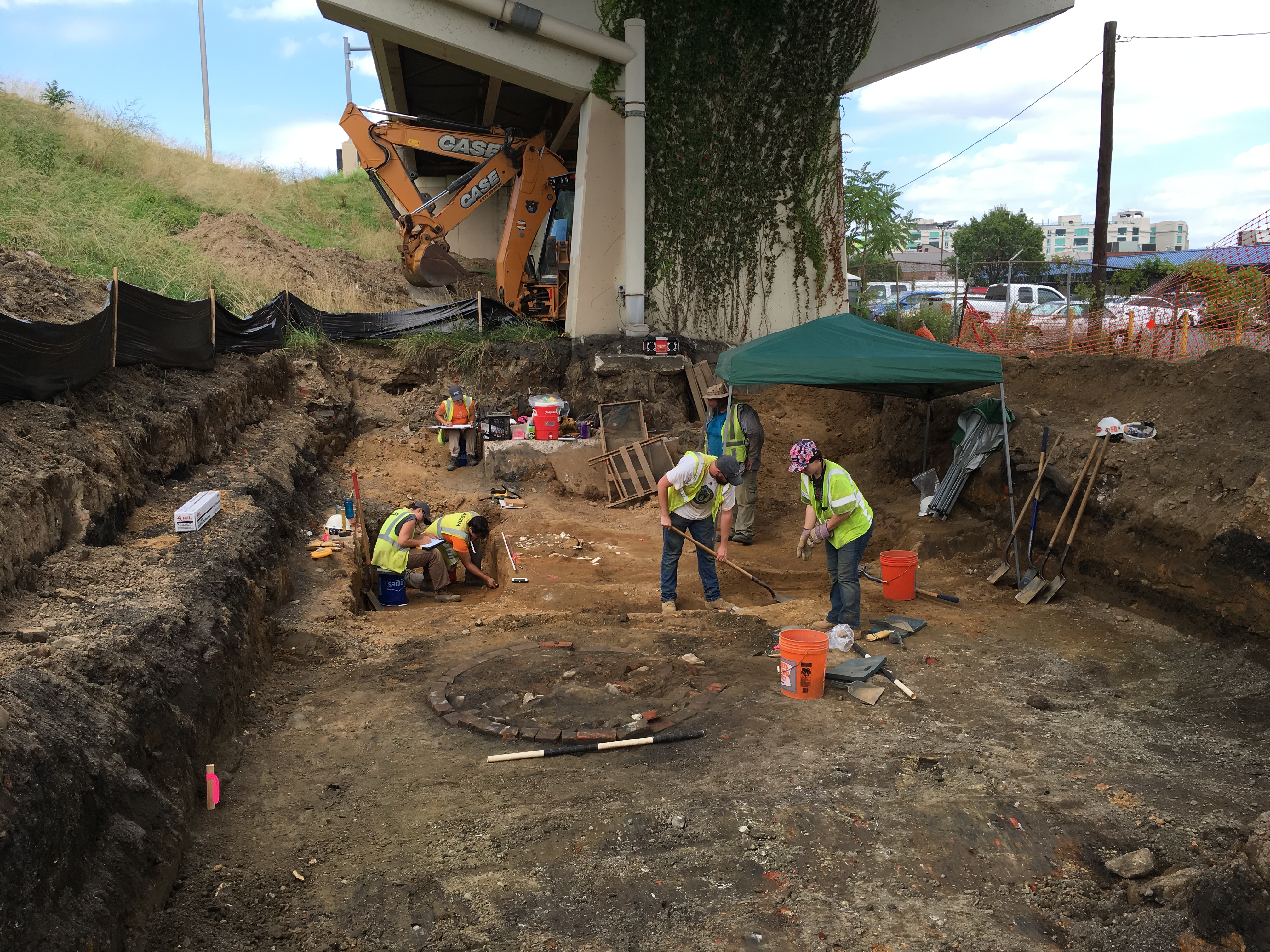Site Page
Pegg’s Run North

Explore
Pegg’s Run North:
| Site Name | Pegg's Run North |
| PASS# | 36PH0228 |
| Image | 1 image site overview |
| Dates of Excavation | 2016 |
| Phase of Excavation | Phase I, II and III |
| Number of Units | 5 |
| Approximate Number of Features Identified | 5 |
| Associated Periods | Mid-eighteenth century to mid-nineteenth century |
| Site Acreage | 7.39 |
Several historic backyards were located within the bounds of the basin. Specifically, the basin encompasses most of the backyards of the former residences at 122 and 124 Noble Street. Based on previous excavations at other sites investigated within the I-95 project area, several feet of modern fill soils usually cap these open spaces beneath the overpass. These soils acted to preserve portions of intact eighteenth- and nineteenth-century backyards.
Mechanical excavation revealed historic foundations, features, and deposits in the backyards of 122 and 124 Noble Street. Brick foundation remnants of the two residences were located in the northern extent of the excavation; these remnants are from the original construction of the residences and contained basement deposits. The features/deposits were located under what were later additions to the residences.
The backyard of 124 Noble Street contained a circular nineteenth-century trash/midden deposit (Feature 1) and a round brick privy (Feature 2). An eighteenth-century yard deposit was also encountered in 124 Noble Street’s yard. The backyard of 122 Noble Street yielded another round brick privy (Feature 3) and a square wooden box privy (Feature 5). A schist wall that could possibly be from Philadelphia’s first powder house (circa 1725) was also located in the backyard of 122 Noble Street. This wall was located on the property line of 122 and 120 Noble Street, at the extreme eastern edge of the project area.
The backyard of 124 Noble Street contained the oldest deposits identified at the Pegg’s Run North Site. Beneath the modern overburden from the construction of I-95 and a later nineteenth-century deposit, an eighteenth-century ground surface was encountered. Archaeological investigation of this deposit was carried out through the placement of five 5-foot-square excavation units. The stratigraphic sequence revealed during excavations at Pegg’s Run North exhibited a distinct slope down and towards the south—indicating that these deposits occupied the edge of a landform that followed the same slope direction. Excavation of this area exposed two stratified eighteenth-century yard deposits that contained distinctive eighteenth-century ceramics, such as tin-glazed earthenware, pearlware, creamware, and Philadelphia-made slip-trailed redwares. A geomorphological trench was also excavated to provide a soil profile of the north bank of the Pegg’s Run landform.
Site Page
Pegg’s Run North

| Site Name | Pegg's Run North |
| PASS# | 36PH0228 |
| Image | 1 image site overview |
| Dates of Excavation | 2016 |
| Phase of Excavation | Phase I, II and III |
| Number of Units | 5 |
| Approximate Number of Features Identified | 5 |
| Associated Periods | Mid-eighteenth century to mid-nineteenth century |
| Site Acreage | 7.39 |
Several historic backyards were located within the bounds of the basin. Specifically, the basin encompasses most of the backyards of the former residences at 122 and 124 Noble Street. Based on previous excavations at other sites investigated within the I-95 project area, several feet of modern fill soils usually cap these open spaces beneath the overpass. These soils acted to preserve portions of intact eighteenth- and nineteenth-century backyards.
Mechanical excavation revealed historic foundations, features, and deposits in the backyards of 122 and 124 Noble Street. Brick foundation remnants of the two residences were located in the northern extent of the excavation; these remnants are from the original construction of the residences and contained basement deposits. The features/deposits were located under what were later additions to the residences.
The backyard of 124 Noble Street contained a circular nineteenth-century trash/midden deposit (Feature 1) and a round brick privy (Feature 2). An eighteenth-century yard deposit was also encountered in 124 Noble Street’s yard. The backyard of 122 Noble Street yielded another round brick privy (Feature 3) and a square wooden box privy (Feature 5). A schist wall that could possibly be from Philadelphia’s first powder house (circa 1725) was also located in the backyard of 122 Noble Street. This wall was located on the property line of 122 and 120 Noble Street, at the extreme eastern edge of the project area.
The backyard of 124 Noble Street contained the oldest deposits identified at the Pegg’s Run North Site. Beneath the modern overburden from the construction of I-95 and a later nineteenth-century deposit, an eighteenth-century ground surface was encountered. Archaeological investigation of this deposit was carried out through the placement of five 5-foot-square excavation units. The stratigraphic sequence revealed during excavations at Pegg’s Run North exhibited a distinct slope down and towards the south—indicating that these deposits occupied the edge of a landform that followed the same slope direction. Excavation of this area exposed two stratified eighteenth-century yard deposits that contained distinctive eighteenth-century ceramics, such as tin-glazed earthenware, pearlware, creamware, and Philadelphia-made slip-trailed redwares. A geomorphological trench was also excavated to provide a soil profile of the north bank of the Pegg’s Run landform.